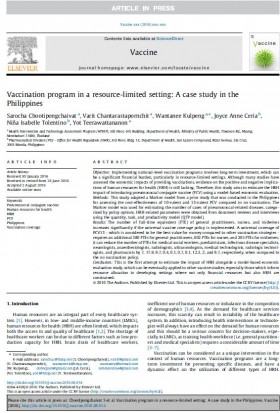This website uses cookies so that we can provide you with the best user experience possible. Cookie information is stored in your browser and performs functions such as recognising you when you return to our website and helping our team to understand which sections of the website you find most interesting and useful.
Vaccination program in a resource-limited setting: A case study in the Philippines

รายละเอียดเพิ่มเติม
Objective: Implementing national-level vaccination programs involves long-term investment, which can be a significant financial burden, particularly in resource-limited settings. Although many studies have assessed the economic impacts of providing vaccinations, evidence on the positive and negative implications of human resources for health (HRH) is still lacking. Therefore, this study aims to estimate the HRH impact of introducing pneumococcal conjugate vaccine (PCV) using a model-based economic evaluation.
Methods: This study adapted a Markov model from a prior study that was conducted in the Philippines for assessing the cost-effectiveness of 10-valent and 13-valent PCV compared to no vaccination. The Markov model was used for estimating the number of cases of pneumococcal-related diseases, categorized by policy options. HRH-related parameters were obtained from document reviews and interviews using the quantity, task, and productivity model (QTP model).
Results: The number of full-time equivalent (FTE) of general practitioners, nurses, and midwives increases significantly if the universal vaccine coverage policy is implemented. A universal coverage of PCV13 – which is considered to be the best value for money compared to other vaccination strategies – requires an additional 380 FTEs for general practitioners, 602 FTEs for nurses, and 205 FTEs for midwives; it can reduce the number of FTEs for medical social workers, paediatricians, infectious disease specialists, neurologists, anaesthesiologists, radiologists, ultrasonologists, medical technologists, radiologic technologists, and pharmacists by 7, 17.9, 9.7, 0.4, 0.1, 0.7, 0.1, 12.3, 2, and 9.7, respectively, when compared to the no vaccination policy.
Conclusion: This is the first attempt to estimate the impact of HRH alongside a model-based economic evaluation study, which can be eventually applied to other vaccine studies, especially those which inform resource allocation in developing settings where not only financial resources but also HRH are constrained.
To download, please go to
http://www.sciencedirect.com/science/article/pii/S0264410X16306715




